February 2024. The canyons here are eroded into mostly Jurassic strata that were deposited near sea level roughly 200 million years ago, and later folded up by orogenic forces that raised them to elevations of up to 10,000 feet. In the recent instant of geological history since our human species reached this continent, this landscape has been occupied by diverse waves of peoples and cultures. Humans wandered here at least 7,000 years ago. Eventually, after many millennia, a farming culture moved in to grow maize, beans, and squash, the crops domesticated in North America, along the rivers. But they abandoned the area around 1,100 CE, probably because of a natural cycle that dried out the climate. After that, and before contact with Euroamericans, this area was occupied by Southern Paiute peoples whose economy adaptively blended some agriculture with a more mobile, nomadic hunter-gatherer lifestyle.1
Geographer John Wesley Powell, who explored the area with teams that included photographers and artists beginning in the early 1870s, called the area by its Paiute name, Mukuntuweap. There is some debate about the meaning of the word, but it seems it could have a range of meanings in Paiute, from “straight canyon” to “the place where the Great Spirit dwells”2 In English, and the Old-World worldview most of us carry, that’s quite a conceptual span; but Native American languages and the worldviews they reflect are noted for their immanent, down-to-earth perspective. Sure, why wouldn’t the Great Spirit want to live in this beautiful place among the cliffs of this straight canyon? It’s a no-brainer, if you think native.
The area is now part of Zion National Park, now the third-most visited national park in the United States, after Great Smoky Mountains and Grand Canyon. The evolution of its name is an interesting lesson in American cultural colonialism—and narrow-mindedness. President William Taft used the power of the Antiquities Act, and the Paiute name of the place Powell had used, to designate Mukuntuweap National Monument in 1909. Acting director of the National Park Service, Horace Albright, visited the monument in 1917, the first interior department official to do so, and fell in love with the landscape. But he felt that “Mukuntuweap” was too hard to pronounce and spell—and was a Native American word, after all. He thought the name itself might deter the tourists he hoped to attract, so in 1918 he persuaded President Woodrow Wilson to rename it “Zion National Monument,” using a name that was popular with some (but not all) Mormons who had settled in the area. The following year Congress officially changed its status to Zion National Park.3
On a short trip in late February, I was one of the early visitors among the five-million-plus people who are expected to visit Mukuntuweap this year—it’s the third-most-visited national park in the United States. I woke up in Falls Church, Virginia, and slept in a cabin at Zion Lodge, with a river of bright stars between canyon walls overhead. It was my first flight in half-a-dozen years during which COVID brought a halt to my air travel. From my window seat as we descended into Las Vegas, I saw the Mukuntuweap landscape splayed out below me—an astonishing view, only possible during this short window of human technological evolution where we can fly, never possible before. Oh yes, and now you can find almost the same views by zooming in on Google Earth. It’s miraculous, I know, to have a view like this, but flying on planes is not an ecologically sustainable mode of travel. My grandchildren will probably still be able to fly in planes, but I doubt that their children, or later generations, will have that option. It’s just too energy-expensive to be ecologically sustainable, no matter how “convenient” in our hurried age. In his novel The Ministry for the Future, Kim Stanley Robinson envisions air travel some centuries hence in airships, green dirigibles of the future that would be much more energy efficient and somewhat slower, like taking an airborne cruise ship. Sounds lovely to me.
The view from 30,000 feet was spectacular and somewhat surreal, but as I would soon discover, the magic and meaning are down below, only accessible by being inside the landscape and experiencing it in person, feet on the ground. That view will be available to future generations, as long as our species is able to protect and wander in these landscapes. The Paiute knew that and experienced it, even while their shamans may have flown over in their dreams. The five million annual visitors to “Zion” National Park know the magic of the place too.
_______
So did some of the first Euroamerican artists who came into the Mukuntuweap country a hundred and fifty years ago. I’ll focus here on perhaps the most famous of them, landscape painter Thomas Moran. John Wesley Powell invited Moran and a photographer named Jack Hillers to spend the summer of 1873 with him in southern Utah as he continued his survey of the tributaries of the Colorado River. A New York Times writer named Justin E. Colburn also accompanied the group. Powell had realized that visual images of western landscapes could help promote funding for western explorations among eastern elites entranced by their exotic grandeur—a lesson he learned from the Hayden Geological Survey of the Yellowstone country in 1871.4 Moran had accompanied Hayden on that expedition, and his field sketches and giant painting, The Grand Canyon of the Yellowstone, as well as photographs by William Henry Jackson, the expedition’s photographer, are credited with convincing Congress to designate Yellowstone as the world’s first national park in 1872. Only painters like Moran could communicate the enchanting colors of western landscapes in a day when photography was only black-and-white.5
The party left Salt Lake City for Kanab in early July, 1873, and on July 22nd Moran made his way up Taylor Creek, where he made a watercolor sketch of two prominent red sandstone buttes. He named one of them after his travelling companion Colburn. Now called Tucupit Point, “Colburn’s Butte” is the central pinnacle in his painting, with the white cloud overhead; the peak on the right is now named Paria Point.
Two of Moran’s most famous works from Mukuntuweap depict a formation he called “The Gate Keeper,” viewed from the narrows of the Virgin River. Wanting to see the view that Moran had seen and painted, we inquired at the park visitor center, where the young rangers on duty really didn’t have a clue. They sent us on a wild turkey chase for half a day, because instead of Moran’s “Gate Keeper” formation, they sent us looking for “The Sentinel,” another named formation in a different part of Zion Canyon. When we realized we were stymied, we took a hike up the Riverside Walk toward the entrance to The Narrows, and stumbled upon Moran’s view in late afternoon light that almost exactly duplicated that of his watercolor sketch from 1873.
Back in his studio in East Hampton, New York, Moran used his watercolor field sketches over the next several decades to produce woodcuts and oil paintings. According to Moran biographer Donna Poulton,
It is widely known that when Moran translated his more literal and contoured field sketches to large oil paintings in his studio, he romanticized the scenes to evoke the sensations and impressions he had experienced on site. Like British landscape artist J. M. W. Turner, with whom he most closely aligned his style and philosophy, Moran made no secret of his method, telling a writer for American Painters Magazine, “I place no value upon literal transcripts from Nature. My general scope is not realistic, all my tendencies are toward idealization...Topography in art is valueless...The forms are extremely wonderful and pictorial...I did not wish to realize the scene literally but to preserve and to convey the true impression.” 9
_______
The 19th century was a unique time in our national encounter with the nature of North America. Andrew Jackson, seventh president of the United States, served two terms, from 1829 to 1837. He was a fierce proponent of “Manifest Destiny” and westward expansion of Euroamerican culture into and across Native America, which his policies helped realize. He signed the Indian Removal Act of 1830, forcing tribes living east of the Mississippi River to travel the “Trail of Tears” from their homelands to new reservations in what later became Oklahoma.
Thomas Cole, founder of the Hudson River School of American landscape painting, hated Andrew Jackson. He expressed his loathing of Jackson most blatantly in a series of five paintings, The Course of Empire, made between 1832 and 1836.11 Cole’s paintings and essays from the 1820s to 1840s are passionate arguments for a worldview opposite to Manifest Destiny: a view of nature as a source of meaning and beauty, a romantic view of Native American and pastoral cultures, and a rejection of the conversion and subjugation of nature for merely human ends.
Cole was not only a painter but a writer, and he tried to explain in words the message of his paintings in his “Essay on American Scenery,” published in the Atlantic Monthly magazine in 1836. He chastises his fellow Americans, writing “It would seem unnecessary to those who can see and feel, for me to expatiate on the loveliness of verdant fields, the sublimity of lofty mountains, or the varied magnificence of the sky; but that the number of those who seek enjoyment in such sources is comparatively small. From the indifference with which the multitude regard the beauties of nature, it might be inferred that she had been unnecessarily lavish in adorning this world for beings who take no pleasure in its adornment.” Many of them, he says, drown themselves in “pursuits of avarice, or the gaudy frivolities of fashion, unobservant of nature’s loveliness.” They are “short lived, short sighted.” He calls for his generation to recognize a transcendent value in the “wildness” of the North American continent.
Both Moran and Albert Bierstadt are associated with the Hudson River School, although neither actually studied with Cole. They carried his philosophy of “American scenery” westward, extolling in their art the beauty, grandeur, and sublimity of the continent. They travelled in much wilder landscapes than Cole, but they were reflecting something Cole described using the old word “sublime,” something we can still feel today.
So where does this history situate the relationship between Moran—an acolyte of Cole’s—and John Wesley Powell, whose geographical explorations aided and abetted American westward expansion? After his survey of the Green and Colorado Rivers in 1869, which included the daring exploration of the Grand Canyon by boat, Powell returned to the area on another expedition in 1871 and 1872; he teamed up with Mormons from Salt Lake City, whose leaders were already sending exploring parties to find new areas for the members of their sect to settle.
Powell is one example of an educated American of his day trying to come to terms with the geography and ecology of the “New World” of North America. He carried his Eurocentric worldview with him as he explored the southwestern regions of the continent. He looked at the dry western landscapes beyond the hundredth meridian and saw that water was an ecological limiting factor and they could and should never be farmed.12 In that regard, he was right.
In 1881 Powell was appointed by President James Garfield as the director of the U.S. Geological Survey, a post he held until 1894. Overlapping that responsibility, from 1879 until his death in 1902, Powell directed the Bureau of Ethnology, which he saw as having the mission “to organize anthropologic research in America.” Based on his interactions with Native Americans on his surveying expeditions and conditioned by his historical and cultural context, Powell is generally seen to have been a “social Darwinist.” He viewed American Indians as occupying a lower rung on the ladder of human political and social evolution, and “advocated for government funding to be used to ‘civilize’ Native American populations, pushing for the teaching of English, Christianity, and Western methods of farming and manufacture.”13 But his Bureau of Ethnology employed Franz Boas (1848-1942)—the founding father of a later school of American anthropology—as a linguistic researcher as early as 1890, when Boas conducted linguistic research among coastal tribes in Oregon. Boas would become famous for his “cultural relativism,” a rejection of the view held by Powell that societies progressed through a hierarchy of cultural and technological stages with Western European culture at the peak.
What were artists like Thomas Moran searching for? Why did this landscape inspire them? Moran said that “Southern Utah is where Nature reveals herself in all her tumultuous and awe-inspiring grandeur… There is a cañon off the Rio Virgin known in the local Indian vernacular as Mu-koun-Tweap, that for glory of scenery and stupendous scenic effects cannot be surpassed. Its cliffs rise up in rugged massiveness for 5000 feet, with some of the most peculiar formations believable toward the top. It is a marvelous piece of nature’s handiwork that is worth going a long distance to see.”14
What are the five million people who visit “Zion” searching for? What is the motivation, what is the value, to us humans, of these immense, nonhuman landscapes.? Why do they trigger an emotional, aesthetic, psychological response that is somehow attractive or addictive?
What was I looking for?
Deep time. Something bigger than human busy-ness and self-absorption, older and more enduring than our temporal myopia. Context for our short eras of Manifest Destiny and Screen Addiction and whatever will come in the future before we settle down and learn to live in our place once again. Something to hint at some kind of deeper meaning in our ephemeral little lives.
And here it is, staring us in the face, dwarfing us, humbling us, quieting us, filling our hearts with its beauty.
_______
And here’s a parting thought—or shot?: Deb Haaland, from Laguna Pueblo in New Mexico, is the first Native American secretary of the interior in our history. She’s been fierce in her advocacy for Native rights and the incorporation of Native voices in the management of public lands. Isn’t it about time that “Zion” National Park regain its original Paiute name, Mukuntuweap? And beyond that, maybe this is the time to begin the process of restoring Mukuntuweap to its rightful owners, reversing the American version of “Zionism,” which stole their land and carried out genocide against them. Isn’t this as good a time as any to begin to give “Zion” back to the Paiutes?
For related stories see:
- The Art of Ecology: Sketching with Cole and Church, May 2015
- Another Conversation with Thomas Cole, February 2018
- Revisiting Cole’s View of the Oxbow, April 2018
- In Search of the Sublime with Albert Bierstadt in Colorado, July 2015
- In Search of the Sublime with Albert Bierstadt in Brooklyn, February 2016
Notes and sources:
- National Park Service, Zion National Park, “History and Culture,” last updated March 5, 2024. https://www.nps.gov/zion/learn/historyculture/index.htm. National Park Service, “About the Southern Paiute,” last updated May 18, 2021. https://www.nps.gov/articles/about-the-southern-paiute.htm
- Bruillard, Nicolas. “How Mukuntuweap National Monument Became One of the Nation’s Most Popular Parks,” National Parks and Conservation Association Blog Post, March 15, 2018. https://www.npca.org/articles/1784-how-mukuntuweap-national-monument-became-one-of-the-nation-s-most-popular
- Bruillard, Nicolas, op. cit.
- Poulton, Donna, “Thomas Moran (1837-1926),” Coeur d’Alene Art Auction 2017. https://cdaartauction.com/auction/2017/lot/19067
- Wikipedia, “The Grand Canyon of the Yellowstone (1872),” last updated November 12, 2023. https://en.wikipedia.org/wiki/The_Grand_Canyon_of_the_Yellowstone_%281872%29
- Photo of a Paiute youth, Thomas Moran, and J.E. Colburn, 1873. http://www.my-west.com/painting-and-sculpture/tag/zion
- Colburn’s Butte, South Utah, Thomas Moran, 1873 (watercolor). http://www.my-west.com/painting-and-sculpture/tag/zion
- In the Narrows, Zion Valley, the Gate Keeper, Thomas Moran, 1873 (watercolor). https://collections.gilcrease.org/object/02878
- Poulton, Donna, op. cit.
- The Rio Virgin, Southern Utah, Thomas Moran, 1917 (oil on canvas). https://cdaartauction.com/auction/2017/lot/19067
- Byers, Bruce, 2018, “Another Conversation with Thomas Cole.” http://www.brucebyersconsulting.com/another-conversation-with-thomas-cole/
- Stegner, Wallace, 1992, Beyond the Hundredth Meridian: John Wesley Powell and the Second Opening of the West. https://www.amazon.com/Beyond-Hundredth-Meridian-Wesley-Opening/dp/0140159940
- John Wesley Powell. https://en.wikipedia.org/wiki/John_Wesley_Powell
- Poulton, Donna, op. cit.

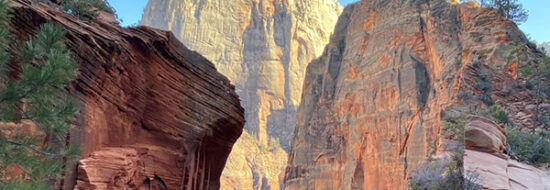
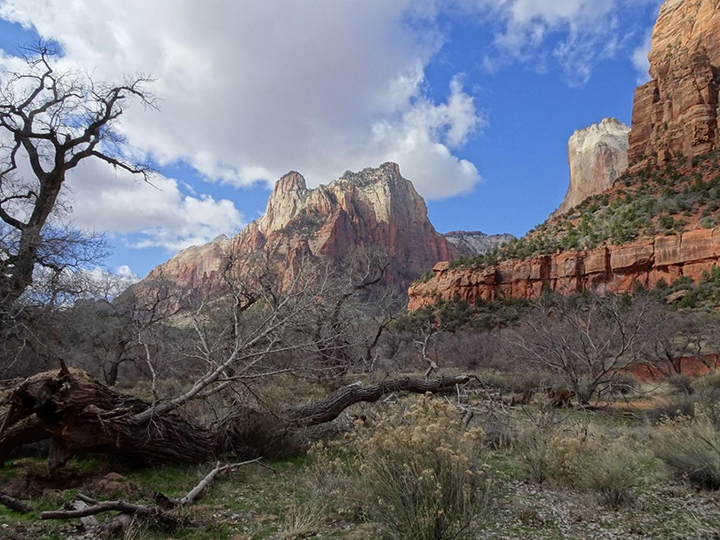
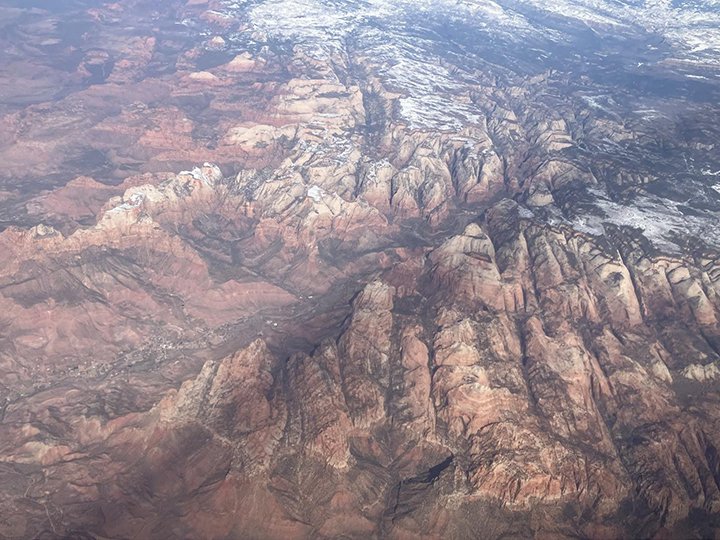
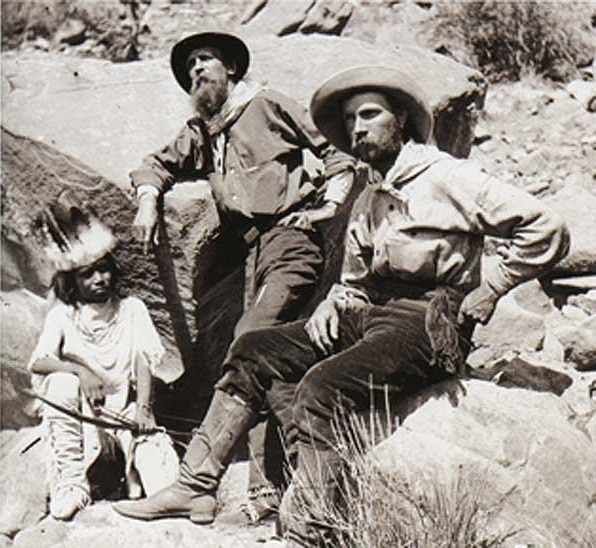
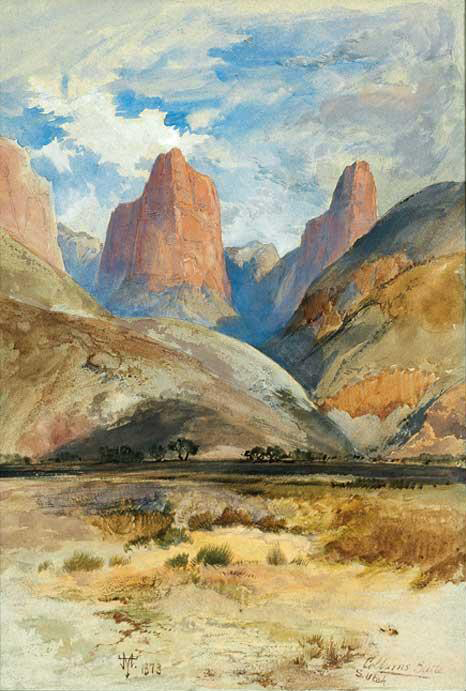
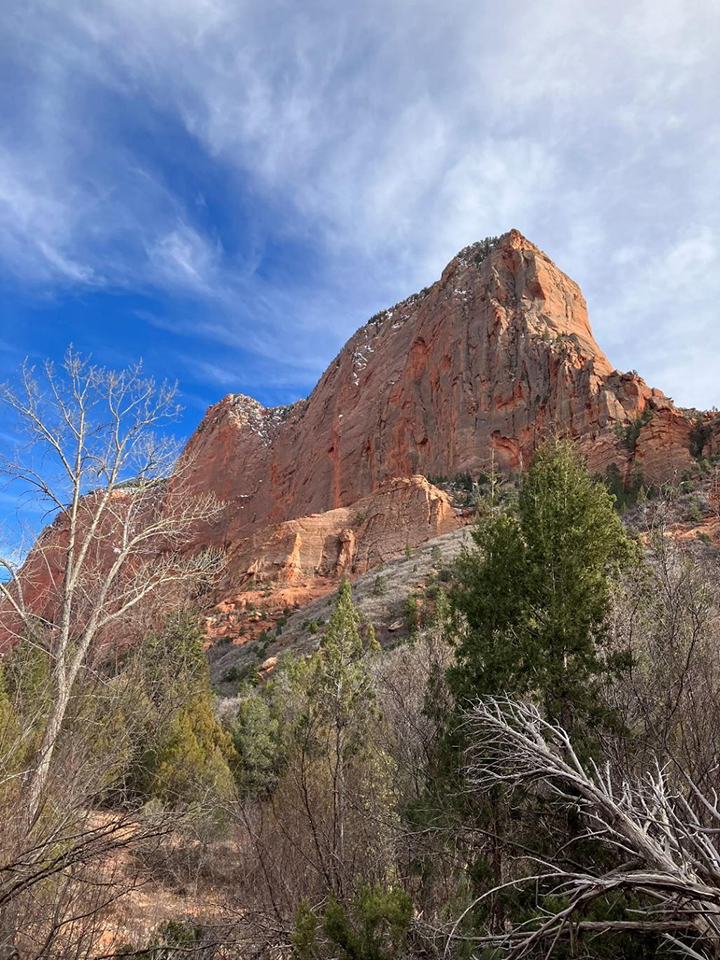
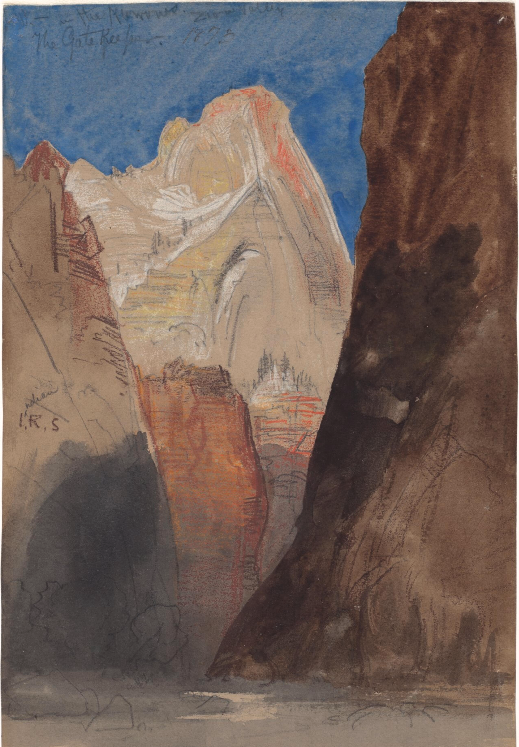
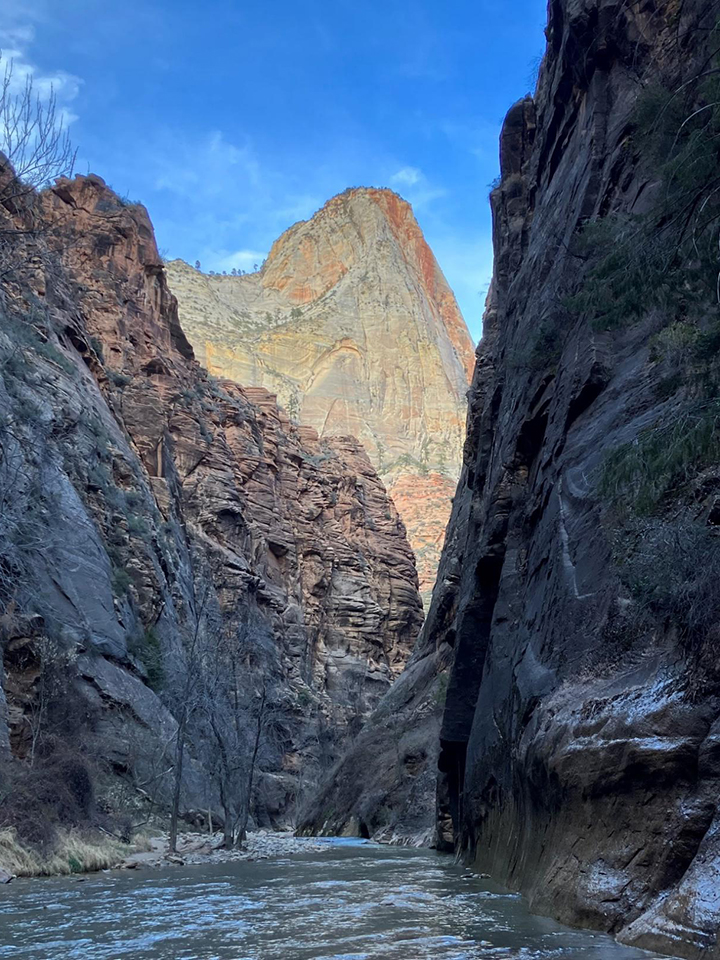
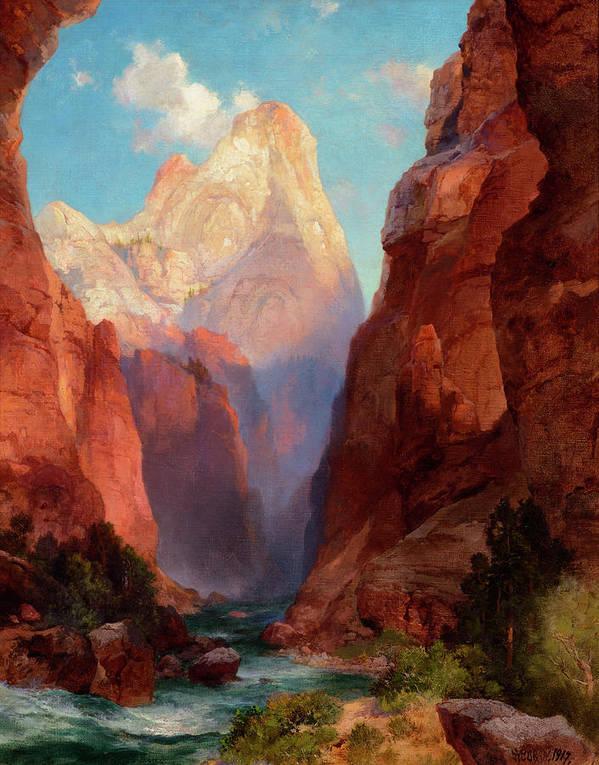
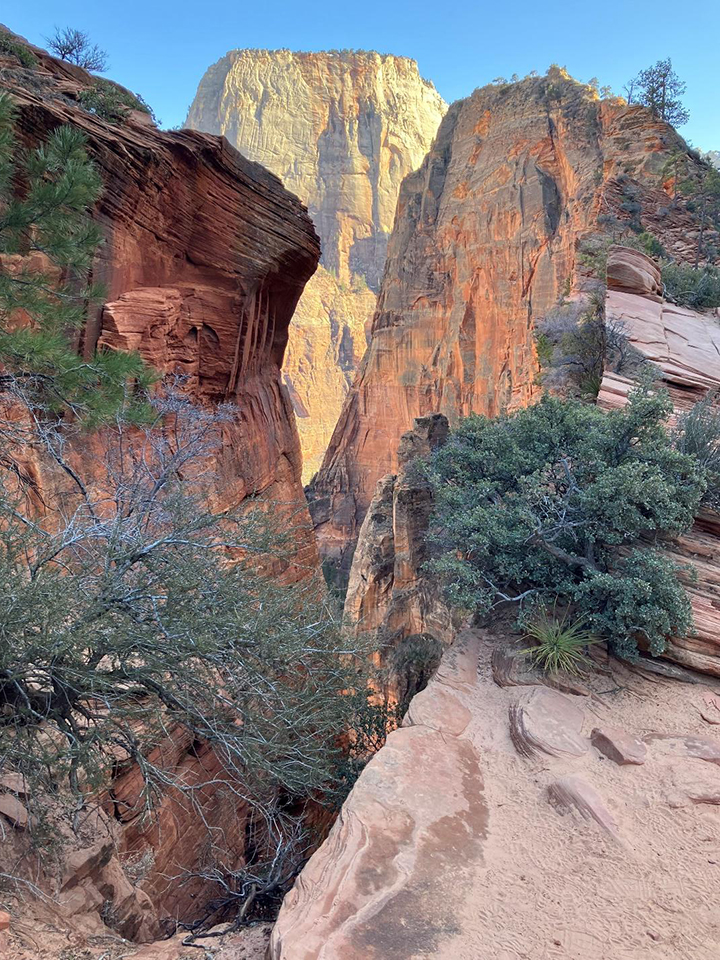
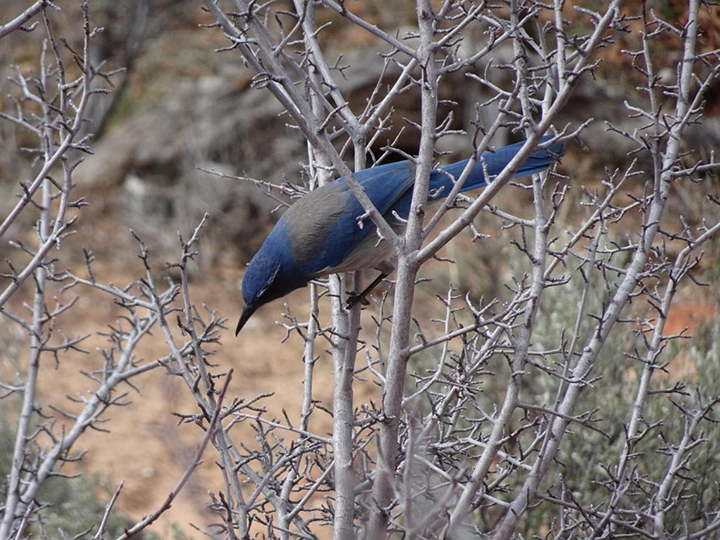
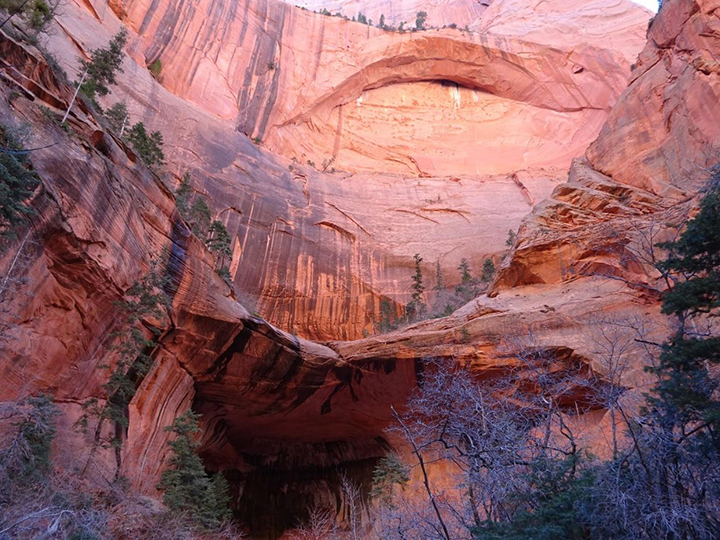

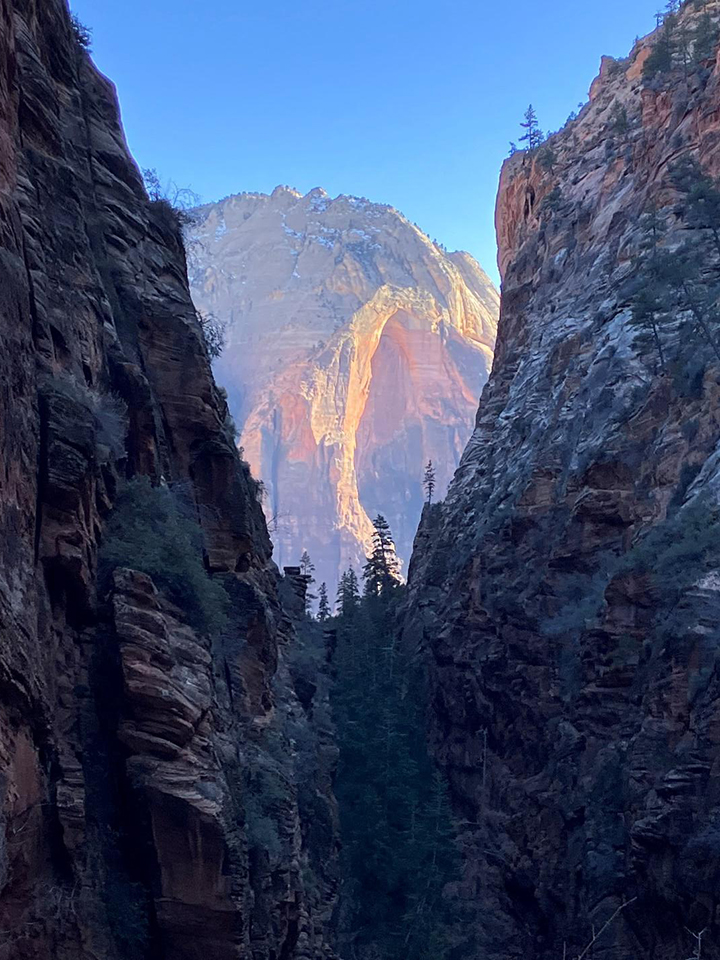
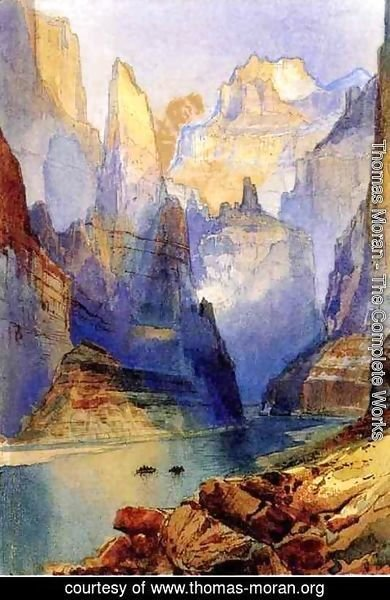



April 1, 2024 5:38 pm
Great photos! And nice pairing with Moran’s art.
April 2, 2024 5:50 pm
Bruce,
At one time I also believed that the Native Americans could do a better job managing our national parks. But I changed my mind when I visited the Mescalaro Apache Reservation near Ruidoso, New Mexico last year. I learned that in many ways Natives can be even worse than the National Park Service in managing natural areas. For example, although I don’t really fault their “Ski Apache” ski resort, including their “scenic gondola” at the top of one of the “sacred” peaks on their reservation, such a resort would not be acceptable in a National Park. Similarly, I felt that despite many environmentalists’ claims that Natives can manage natural areas better than government agencies, I was truly disappointed to discover that the largest lake – and one of the very few lakes in those mountains – had a gigantic casino-hotel on it, an associated large parking lot, a lot of non-natural barren soil, and other high-impact development. The Tribe also had a pretty large-scale logging operation going on – quite visible. So much for maintaining “sacred” lands. I don’t fault them for wanting to make money off the white populace, foolish though that populace may be, but that kind of development would not be acceptable in any national park. I know there has been several national magazine articles urging parks to be turned over to tribes. But I believe it is much more complicated than they would lead you to believe.
April 4, 2024 4:50 pm
Thanks for your thoughtful comment. You took my “bait” in that provocative statement at the very end of the post where I said that maybe we should give Mukuntuweap/Zion back to the Paiutes—it was a test to see how many readers read the whole thing, and you get the first “A”!
Seriously though, the situation on the Mescalero Apache Reservation near Ruidoso sounds strange and incongruent with a vision of “sacred lands,” as they describe the place on their tribal website https://mescaleroapachetribe.com/ We shouldn’t romanticize Native American environmental values and worldviews, although they were generally ecocentric, rather than anthropocentric—much more like the views of John Muir than those of most of his contemporaries, or those of our countrymen and countrywomen even now. I’m glad Muir and Moran helped push the idea of national parks and the protection of non-material values of nature among Euro-Americans. Even though Mukuntuweap/Zion has a big lodge within the park in Zion Canyon, it’s not a huge casino. And you still have to climb Angel’s Landing on your own two legs rather than ride a cable car.
The Mescalero case is worth noting and comparing with other situations of tribal land management or tribal participation in co-management of federal lands. I’ve been impressed with the Indigenous voices that have supported protection for Bears Ears National Monument through the Bears Ears Inter-Tribal Coalition (the Hopi Tribe, Navajo Nation, Ute Mountain Ute Tribe , Pueblo of Zuni, and Ute Indian Tribe) https://www.bearsearscoalition.org/about-the-coalition/, and the involvement of several tribes in the new Avi Kwa Ame National Monument in southern Nevada https://www.blm.gov/avi-kwa-ame-national-monument. I’m hoping that the proposed Chumash Heritage National Marine Sanctuary will be designated by NOAA this summer and that Northern Chumash and related tribes from the San Luis Obispo and Morrow Bay area will have a strong co-management role. I believe that revitalizing Indigenous Native American worldviews and values can help shift our culture toward a more respectful relationship with the biosphere.
And I wasn’t joking in proposing that Zion be re-renamed Mukuntuweap National Park!
April 5, 2024 10:59 pm
Yes, the different tribes in different areas can have very different approaches to managing their own Nations- which is as it should be. I recall years ago there was much controversy within the Navajo tribe itself over whether to build the coal-fired Four Corners Power Plant – – the “pro-development” wing won that battle against those within the tribe who felt they shouldn’t pollute their pristine landscape. So for decades – since it was built in the early 1960’s, it has been burning the worst kind of global warming pollution – coal – and contributing to global warming. It has now been announced that the Power Plant will be decommissioned by the end of 2031, seven years ahead of the originally scheduled closure date of 2038.
In any case, I am all in favor of renaming Zion Mukuntuweap National Park!